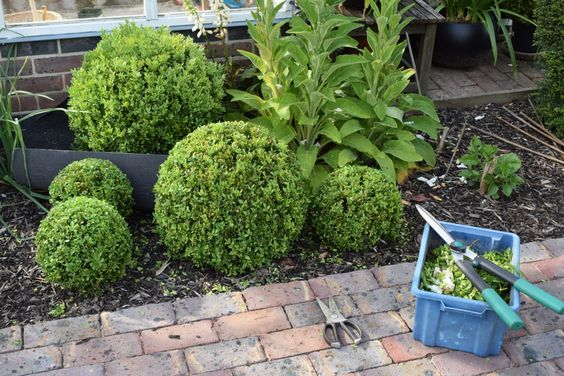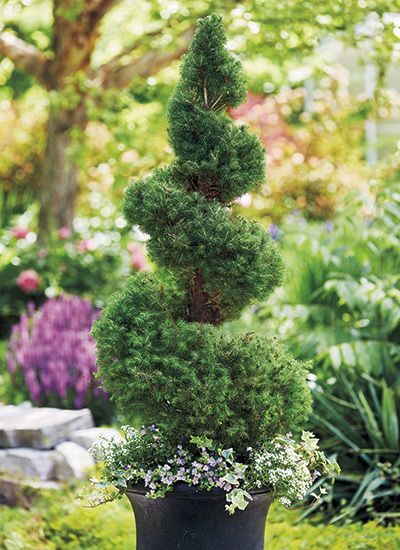Topiary is a genre of art in which humans manipulate typically living plants into complicated forms and structures. You may use topiaries to decorate your landscape and add a splash of color to your display. Depending on where you chose to arrange your topiary, you may either create the appearance of space and depth or conceal undesirable aspects.
Topiary is a practice that extends back thousands of years. It is believed that the Egyptians created the art form before the Romans adopted it. However, it is debatable if topiary from the Far East, such as cloud pruning, originated first. Many forms of topiary art have emerged over the centuries. Topiaries can take a variety of forms, ranging from enormous animals and realistic human-shaped sculptures to the towering spirals seen in prominent formal gardens.
Your guide to growing a topiary: Starting from scratch
Selecting a form
Balls, pyramids, and cubes are the three shapes that offer the least complicated starting points for beginners. Try carving a sculpture in the shape of an animal or a spiral if you’re feeling up to the task. Tall and vertical designs may need a larger stem, while large horizontal structures might call for several.
Get your plant off the ground
Grow plants one at a time in separate containers. You can either start from seeds or buy already-grown plants. Make sure to water and feed your plants in small, frequent amounts to encourage even growth. You can mulch your little plant in the spring if it is not being cultivated in gravel.
Plant pruning
The plant’s edges should be trimmed every two to three centimeters during the growing season.
Select a shoot to be the primary support for your topiary if you want it to take the shape of a lollipop. The selected node will have a tiny amount of support applied, and the rest will be removed. Keep cutting down competing shoots and leaves, but don’t touch the top of the plant. Repeat this process until the desired height of the stem is reached.
The topiary can be clipped into shape once it has reached an apparent size. This can be done freehand, or a frame or template can be purchased for a little fee. Once your plant is established, cut it once a year throughout the growing season; however, more rapid growers may require twice-yearly trimming.

Source: Pinterest
Issues
Since pests and diseases can do more damage to young plants, extra attention may be needed.
It takes time and effort to get little plants established, but the payoff is well worth the effort.
Leaves may turn brown after being treated with fertilizer, water, or pruned. Try feeding and watering less frequently but more lightly, and cutting back fading leaves in the spring to combat this.
Having their roots contained in a container makes topiaries more vulnerable to Root Rot.
Both Box Blight and Box Tree Moth can affect box plants.
5 different garden topiary shapes and designs
Decorate entryways and garden entrances
When placed on either side of a doorway or garden entrance, topiaries create a stunning visual effect. Topiaries are a good way to add a decorative touch to your yard, porch, or front door while also boosting your home’s curb appeal.
Use height and texture in the design of beds and borders
Expert garden designers and landscapers frequently include topiaries in the design of flower beds and other landscape elements. Layering a border with regular plants and topiaries is an easy method to add height and structure, and it works especially well with a modern or formal garden design scheme.
Use topiaries to trick the eye
If your yard has an old wall or a boring concrete floor, you can cover them up with topiary plants. Topiaries, in a similar vein, can be strategically placed around benches, water features, and obelisks to draw attention to and highlight these focal points. Topiaries put along garden edges and walks can make a small garden or outdoor space feel more expansive and deep by creating visual breaks in the visual field.

Source: Pinterest
Make your topiary a statement element
Topiaries are a great way to give drama and depth to any size garden, whether you have a lot of room outside or not. Put a regular plant or topiary in a lovely container in your preferred garden design to liven up a boring section of your patio or balcony.
Give a fall or winter garden some definition.
Topiary, whether in the form of clipped cubes, big leafy animals, or towering spirals, is a wonderful way to liven up a garden. Create a border full of year-round color and texture by combining sculpted sculptures with evergreen plants with intriguing foliage for a wonderful winter garden.
FAQs
What are topiary plants?
The skill of shaping plants (usually evergreen shrubs and trees) into elaborate or stylized patterns and forms is known as topiary.
Can topiaries grow in pots?
Topiary can be planted directly into the ground or kept in pots to decorate patios, decks, and doors, among other locations.
Housing News Desk is the news desk of leading online real estate portal, Housing.com. Housing News Desk focuses on a variety of topics such as real estate laws, taxes, current news, property trends, home loans, rentals, décor, green homes, home improvement, etc. The main objective of the news desk, is to cover the real estate sector from the perspective of providing information that is useful to the end-user.
Facebook: https://www.facebook.com/housing.com/
Twitter: https://twitter.com/Housing
Email: [email protected]











